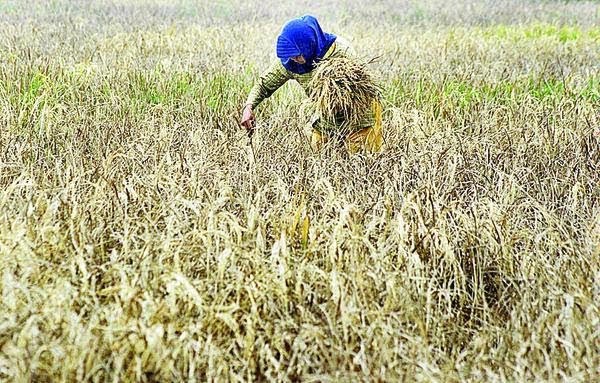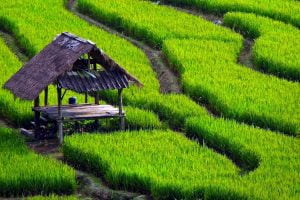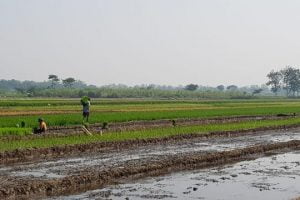
The availability of agricultural land is an important condition for achieving food self-sufficiency. This means that land must always be available in sufficient quantities. In addition, land must always be productive and optimally developed to achieve a certain amount of productivity in line with population growth. In Indonesia, the land on which to achieve food self-sufficiency is land owned by farmer families. The green revolution developed by Indonesian government is essentially the optimization of farmer-owned-land in order to achieve high productivity so as to obtain adequate results for the population. Therefore, the farming family is responsible for providing food for various other parties.
People Agriculture
Referring to Mubyarto, Rahardjo (2017) argues, the form of food agriculture in Indonesia is people agriculture, which is a type of agriculture that is cultivated by farming families. In this case, Mubyarto distinguishes between agriculture managed by agricultural companies that are profit-oriented and farming activities managed by farming families. The dualism between capitalistic agricultural enterprises and people agriculture is a colonial legacy that is still being felt until the independence era, or even in this modern era. Until now, we are still witnessing the existence of agricultural land managed by companies (whether state-owned companies or private companies) and agricultural land owned and managed by farming families – or what is often called people farms, family farms, or smallholders. According to Rahardjo (2017), this people agriculture has main characteristics: (a) narrowly managed land area, (b) food crops, such as rice and secondary crops, are the main commodities; (c) complemented by horticulture (vegetables and fruits); and (d) coupled with livestock and fishery activities in small quantities, as well as looking for forest products.
Many foreign researchers, such as Funjimoto (1996), Neef (1999), and Nabangchang & Srisawalak (2008) confirm that this family farming system is the basic structure of land tenure (patterns of land ownership and control) in Southeast Asia, especially in the provision of food. The agricultural system in Indonesia is an inseparable part of the agricultural system in Southeast Asia, with its variations. Based on the results of his research in Ranca Ekek and Ranca Udik, Bandung Regency, Indonesia, Fujimoto (1996) confirmed that the family farming system in the village was still dominant. From the 98 families in Ranca Udik, there are 59 farming families (60.20%) with an average land area of 0.64 hectares per farm family. Whereas in Ranca Ekek which is geographically closer to the urban area, there are only 10 families who work as farmers out of 93 families in the village, that is, there are only 10.7% of farming families, with an average land ownership area is merely 0. 44 ha per family.
The Ranca Ekek and Ranca Udik villages are very interesting cases. This seems to emphasize that efforts to achieve food self-sufficiency in Indonesia are a burden on gurem (small) farmers. This is reinforced by data from the 2003 and 2013 Agricultural Census which have confirmed that smallholders serve as food providers for the Indonesian population. In terms of quantity, in Indonesia there are 14 206 thousand smallholder farmers based on the 2003 Agricultural Census. This number has decreased to 14 206 thousand families based on the 2013 Census. In more detail, referring to the 2013 Agricultural Census (BAPPENAS, 2014), the average control of rice fields for each farming family is 0.69 hectares. In more detail, the average rice field ownership in Sumatra is 0.68 hectares, in Java 0.61 hectares, in Bali & Nusa Tenggara 0.70 hectares, 0.78 hectares in Kalimantan, 1.32 hectares in Sulawesi and Maluku & Papua around 2.72 hectares.
The Gurem Farmers are Still Dominant
The smallholders in Indonesia are still very dominant as food providers for various parties in this country. The data from the 2018 Inter-Census Agricultural Survey (BPS, 2018) show that smallholder – those who control agricultural land under 0.5 ha – total 15 890 427 families. The more agricultural land controlled – or owned – the less number of farming families who control the land. Those who control the land between 0.5 ha to 0.99 ha are 4 338 150 families; and only 3 813 252 families control land between 1.0 ha to 1.99 ha across Indonesia. Those controlling the land between 2.00 ha to 2.99 ha were 1 570 333 families. According to the BPS (2018), there are only 78 603 families who are considered as the richest farmer – namely those who control land for 10 ha or more (Table 1).
These smallholders are concentrated sequentially in East Java, Central Java and West Java, with a total of 4 055 438 farming families, 3 618 041 families and 2 528 743 farming families. Thus, the burden of achieving food self-sufficiency in Indonesia – or to obtain national food security – is more a burden on farming families in Java. For areas outside Java, the concentration of smallholders is higher in North Sumatra (725 482 families), Lampung (501 489 families), NTB (419 669 families), South Sulawesi (393 766 families), Aceh (366 283 families), NTT ( 351 220 families), and West Sumatra (338 426 families) (BPS, 2018).
Table 1. The Average of Farming Land Ownership in Indonesia
| Land Size (ha) | The Number of Family Farming who Control Land | ||
| Farming Land | Rice Field | Non-Rice Field | |
| ≤ 0,5 | 15 890 427 | 9 869 797 | 14 687 017 |
| 0,5-0,99 | 4 338 150 | 1 996 580 | 2 700 051 |
| 1,0- 1,99 | 3 813 252 | 851 205 | 2 969 102 |
| 2,00-2,99 | 1 570 333 | 183 389 | 1 315 808 |
| 3,00 – 3,99 | 571 831 | 51 810 | 468 936 |
| 4,00 – 4,99 | 303 106 | 21 017 | 260 749 |
| 5,00 – 9,99 | 338 908 | 20 565 | 291 667 |
| ≥10,00 | 78 603 | 4 536 | 71 143 |
| Total | 26 904 610 | 12 998 899 | 22 464 473 |
Sources: The Result of Inter-Census Agricultural Survey (BPS, 2018)
Regarding the rice fields which are the main media for rice production as a staple food – which is the focus of food self-sufficiency – in Indonesia there are 12 998 899 farming families who control rice fields, both property rights and cultivators. Of these, 9 869 797 families (76%) were smallholders with a rice field area below or equal to 0.5 ha. The farmers who own land between 0.5 – 1.00 ha are only 1,996 580 families (15% of all rice farmers). According to BPS, there are only 25 101 farmers who control rice fields of 5 ha or more (only 0.0019 percent from the all number of family farming).
In this case, what can be said is that efforts to achieve food self-sufficiency in Indonesia – especially rice – in addition to the very small number of farming families compared to the number of families in Indonesia, are also very dependent on smallholders. As with the control of agricultural land in general, the number of smallholders who control rice fields is still concentrated in East Java, Central Java and West Java, with the number of farming families sequentially is 2 499 681 families (17.3%), 2 189 farmer families (16 , 8%) and 1 900 679 families (14.6%). In short, almost 50 percent of the small rice farmers are concentrated in Java. Thus, the small rice farming families in Java have the responsibility of being a “food hero” for all Indonesian citizens.
The area of land owned by farmers is very important to pay attention as an effort to achieve food self-sufficiency. In addition to being less efficient as a business activity, the narrow land area will also be difficult for farmers to apply managerial patterns and implement technological innovations to increase rice production. In addition, the narrow land is not sufficient for farmers’ needs, so it will obscure the concentration of farming activities because they have to carry out various other activities outside of farming to meet their family’s needs.
The result of Sari and Munajat’s research (2019) in Jayapura District, OKU Regency, South Sumatra, needs to be considered to illustrate the importance of adequate land area per individual or farmer family. Taking into account the area of land, the income from rice farming activities in accordance with the area of land they have, as well as the expenditure of farmers ‘needs at the local level, it turns out that 0.25 ha of land is not sufficient for farmers’ needs. The area of 0.5 ha also does not cover the needs of farmers. Likewise, the land area of 0.75 ha is not sufficient for a normal life necessity. The living needs of farmers have begun to be fulfilled with a minimum land area of 1 ha. In this study, the two researchers analyzed land areas ranging from 0.25 ha to 2.00 ha. It turns out that the minimum limit for rice farming activities that is considered adequate and meets farmers’ needs is 1.0 ha. The higher the land area owned, automatically the better the welfare of the farmers.
In line with these results, Sumarno (WY) analyzed the difficulties of efforts to achieve food self-sufficiency in Indonesia. Even though in the 1980s Indonesia was considered to have achieved very encouraging food self-sufficiency, but in fact food self-sufficiency is still fragile. Not more than two years after food self-sufficiency, Indonesia is again experiencing a shortage of rice. According to Sumarno (WY), many factors cause the difficulty of food self-sufficiency. Among these is the low per capita farming land area owned by the Indonesian nation. Based on data on farming land area in 2010, namely the area of rice fields in Indonesia is around 7.9 million ha, the area of agricultural land per capita is only 291 m2. When combined with the available dry land based on data for that year, the farming land area per capita in Indonesia is merely 494 m2.
Compared to the agricultural land area per capita in two ASEAN countries, namely Vietnam and Thailand, Indonesia’s per capita farming land area is still lower. The Vietnam’s per capita land area is 735 m2; while Thailand has a land area per capita of 4 020 m2. It is therefore not surprising that Vietnam – which started developing in the early 1980s after the end of the war – became the second country on the global level after Thailand to be able to export rice; and Indonesia is one of the countries that imports rice from Vietnam and Thailand to meet domestic food needs (Bisnis.com, 22 April 2020). In addition, India as a rice exporting country has a land area per capita of 1 328 m2. In comparison, China has a per capita agricultural land area of 708 m2; Australia has 17 699 m2; Argentina 5 672 m2; Brazil 2 980 m2; USA 5 810 m2; and Canada has a per capita land area of 14 203 m2. Thus Sumarno (WY) with reference to FAO-Rice Market Monitor and Rice Al-Manak with a projection that in 2020 Indonesia’s population will reach 271 million people;
Apart from the availability of adequate land, the quality of land management and the factors that support it are essential. All available land is expected to be productive and produce maximum rice. However, this is still a problem. In 2018, the Ministry of Agriculture – based on a coordination meeting in Solo, 25-27 July 2028 – estimated the harvested area in Indonesia would reach 15 994 512 ha with the assumption that all available land could be planted in two planting seasons in one year, and with growth of 1.8% from the previous year. But in fact, BPS (2019) reports that the harvest area in Indonesia in 2018 was 11 377 934, 44 ha, only 71.14% of predictions were achieved. This indicates that the rice fields are fully planted in two seasons in one year, due to irrigation factors, it still depends on rain, drought, and pest attacks. This is perhaps what needs attention towards food self-sufficiency.
Reference
Badan Pusat Statistik, The Result of Inter-Census Agricultural Survey, Jakarta: BPS, 2018
Badan Pusat Statistik, “Luas Panen, Produksi, dan Produktivitas Padi Menurut Provinsi” [Rice Harvest Area, Production and Productivity by Province] in https://www. bps.go.id/dynamictable/2019/04/15/1608/luas-panen-produksi-dan-produktivitas-padi-menurut-provinsi-2018.html, visited August 24, 2020
Fujimoto, Akmi. “Rice Land Ownership And Tenacy System in South East Asia: Facts and Issues Based on The Village Studies.” The Developing Economies XXQUOTEDXI, No. 3 September (1996).
Kementeria Pertanian Republik Indonesia, “Luas Panen Padi Menurut Provinsi, 2014-2018,” [Harvest Area by Province, 2014-2018] in https://www.pertanian.go.id/home/?show= page&act=view&id=61, visited August 24, 2020
Nabangchang, Orapan, and Eathipol Srisawalak. Good Governance And Natural Resources Tenure In South East Asia Region. Rome: Food And Agriculture Organization Of The United Nations, 2008.
National Development Planning Board. Analysis of Household, Land, and Agribusiness in Indonesia: Agricultural Census 2013. Jakarta: NDPB, 2014.
Neef, Andreas. “Land Tenure and Soil Conservation Practices: Evidence from South Africa and South East Asia.” In Sustaining the Global Farm (Selected Paper from the 10th International Soil Conservation Organization Meeting, edited by D.E. Stott, R.H. Mohtar, and G.C. Steindhardt. Purdue University and USDA-ARS National Soil Erosion Research Laboratory, 1999.
Rahardjo, Pengantar Sosiologi Pedesaan dan Pertanian [Introduction for Rural and Agricultural Sosiology], Yogyakarta: Gadjah Mada University Press, 2017.
Sari, Fifian Permata dan Munajat, “Analisis Luas Lahan Minimum untuk Memenuhi Kebutuhan Hidup Petani Padi Sawah di Kecamatan Jayapura Kabupaten OKU Timur,” [Analysis of Minimum Land Area to Meet the Living Needs of Rice Farmers in Jayapura District, East OKU Regency], REKAYASA Vol 12(2): 157-152
Sumarno, Kemandirian Pangan Nasional Mengapa Sulit Dicapai Dan Apa Yang Harus Dilakukan [National Food Self-Sufficiency Why Difficult to Achieve And What to Do] (Unpublished Paper)



